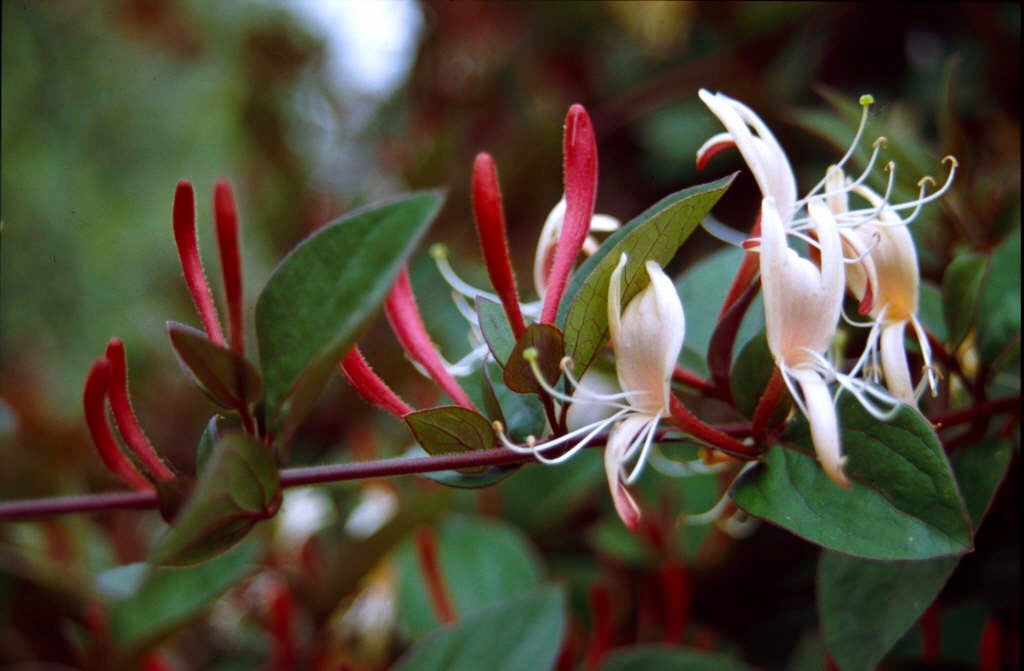Lonicera japonica var. repens
creeping Japanese honeysuckle
A vigorous evergreen climber with purplish stems and leaves, and clusters of strongly fragrant white flowers tinged with purple on the outside

Buy this plant
Size
Ultimate height
4–8 metresTime to ultimate height
5–10 yearsUltimate spread
1–1.5 metresGrowing conditions
Moisture
Moist but well–drainedpH
Acid, Alkaline, NeutralColour & scent
| Stem | Flower | Foliage | Fruit | |
| Spring | Green Purple | |||
|---|---|---|---|---|
| Summer | Purple White | Green Purple | ||
| Autumn | Green Purple | Black | ||
| Winter | Green Purple |
Position
- Full sun
- Partial shade
Aspect
North–facing or West–facing or South–facing or East–facing
Exposure
Exposed or Sheltered Hardiness
H5Botanical details
- Family
- Caprifoliaceae
- Native to GB / Ireland
- No
- Foliage
- Deciduous
- Habit
- Climbing
- Potentially harmful
- Fruit are ornamental - not to be eaten. Wear gloves and other protective equipment when handling. Pets: Fruit are ornamental - not to be eaten - see the HTA guide to potentially harmful plants for further information and useful contact numbers
- Genus
Lonicera can be deciduous and evergreen shrubs, or climbers with twining stems. The tubular or two-lipped flowers, often very fragrant, are followed by red or black berries
- Name status
Correct
- Plant range
- Temperate Asia
How to grow
Cultivation
This plant is listed on Schedule 9 of the UK Wildlife & Countryside Act (Northern Ireland) as an invasive non-native species. Although not banned from sale, it is an offence to plant or cause these to grow in the wild IN NORTHERN IRELAND. Gardeners possessing them should undertake measures to control them. See RHS advice on invasive non-native species for further information Vigorous honeysuckle best in partial shade but tolerates full sun, thrives in any moist but well-drained soil. This species is listed on Schedule 9 of The Wildlife (Northern Ireland) Order (1985), as amended, as an invasive non-native species. While this does not prevent it from being sold or being grown in gardens in Northern Ireland, the RHS encourages those that do grow it to take great care with managing it and with disposing of unwanted material. The RHS also encourages gardeners in Northern Ireland to find alternative plants to grow to those listed on Schedule 9. For suggested alternative plants see the Plantlife/RHS guide, Gardening without harmful invasive plants
Propagation
Please see cultivation notes
Suggested planting locations and garden types
Pests
May be susceptible to honeysuckle aphids, Thrips and glasshouse whitefly
Diseases
May be susceptible to powdery mildews, fungal leaf spot, silver leaf and honey fungus (rarely)
Love gardening
Sign up to receive regular gardening tips, inspiration, offers and more
View our Privacy Policy
Get involved
The Royal Horticultural Society is the UK’s leading gardening charity. We aim to enrich everyone’s life through plants, and make the UK a greener and more beautiful place.